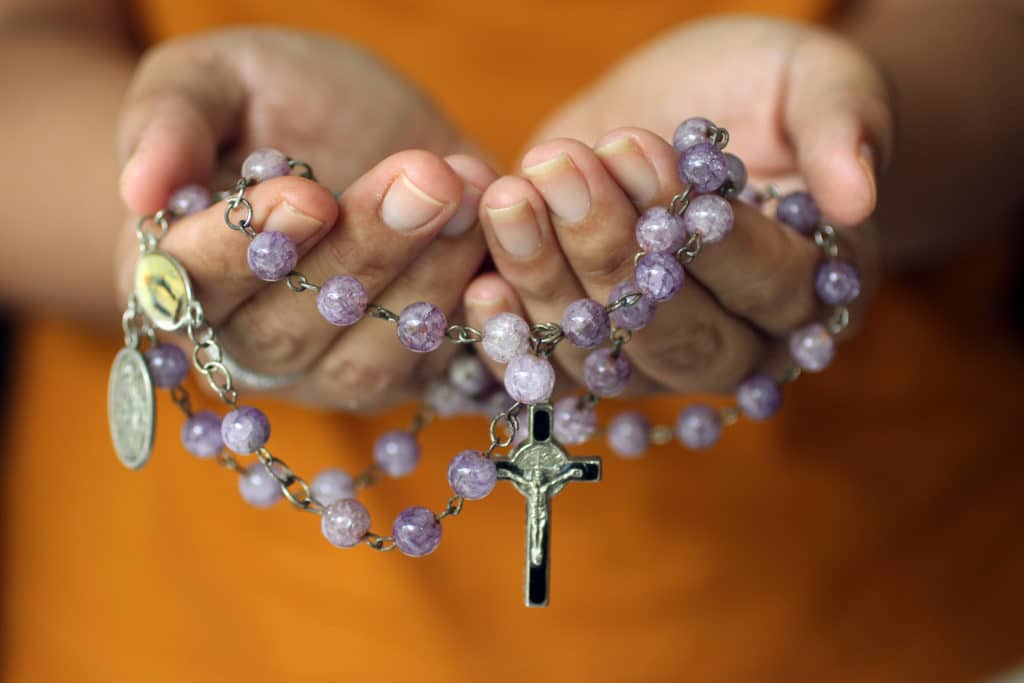Praying The Rosary: Part 1

On Sunday 15 August, the Church celebrates the feast of the Assumption of Mary into Heaven. It is a Holy Day of Obligation for Catholics. As we celebrate this important event, we are reminded to turn to Our Lady by praying the rosary, asking for her intercession at God’s right hand.
In this week’s blog, one of a three-part series on the rosary, we consider one aspect of the rosary so that readers obtain a deeper grasp of this beautiful Marian prayer. It is hoped that at the end of the series, many more in our community will have a greater understanding of and develop a deep love and devotion for this beautiful prayer.
Origins of the Rosary
If you were to ask what object is most symbolic of Catholics, people would probably say, “The rosary.” The rosary, a devotional prayer in honour of Mary, is one of the most cherished prayers of the Catholic Church. It is also a biblical form of prayer as the prayers of the rosary come primarily from the Bible.
The term rosary comes from Latin and means a garland of roses. The rose is one of the flowers used to symbolise Mary. The rosary refers to both the string of beads, and the prayers said using the string of beads. It is made up of a crucifix, one larger bead, three small beads, another larger bead, and then a medal. The rest of the rosary is made up of 50 small beads and five large beads.
For centuries, long before Christ, the Jewish people prayed repetitively and often using rocks or pebbles to keep count of the prayers. Evidence exists from the Middle Ages that strings of beads were used by the Christians to count ‘Our Fathers’. In fact, these strings of beads became known as Paternosters, the Latin for Our Father.
By the ninth century, Christian monks were reciting all 150 psalms. One way they kept count was to count out 150 pebbles and then place one pebble in a container or pouch as they said each psalm. People living near the monks wanted to imitate this devotion, but because they could not memorise all the psalms, they began to pray 50 or 150 Paternosters instead. To keep count, they used string with knots in it instead of counting out rocks. Later the knots gave way to small pieces of wood and eventually to the use of beads. Today, there are various rosary beads available, from the basic to the very elaborate, and almost every Catholic usually has their favourite rosary.
Even though the exact origin of the Rosary is not very clear, what is undeniable, is its growth in popularity through the preaching of Saint Dominic in 1214. Dominic encouraged people to pray the rosary as a remedy to blasphemy and as a cure for sin.
The structure and flow of the rosary are meant to aid the individual in meditation. The rhythm of the prayer can soothe the spirit and help a person be more open to hearing God’s voice. However, genuine and attentive use of the rosary is a requisite to enjoying all the favours that come from a sincere devotion to this prayer.
Now that we have a clearer understanding of the origins of the rosary, next week we delve into the meaning of the prayers and how to pray them. Until then, God bless!
Sources: https://www.franciscanmedia.org/franciscan-spirit-blog/the-origins-of-the-rosary
Sources: https://simplycatholic.com/where-did-the-rosary-originate/
Sources: https://stpaulcenter.com/a-short-history-of-the-rosary/
Sources: https://www.ewtn.com/catholicism/library/history-of-the-rosary-1142

Combating The Attention Span Crisis In Our Students – Jennifer Oaten
It is no secret that attention spans have been steadily declining, especially among younger generations growing up immersed in digital technology. The average person’s attention span when using a digital device has plummeted from around two and a half minutes back in 2004 to just 47 seconds on average today – a dramatic 66% decrease over the past two decades.

Weekly Wrap Up: Term 2, Week 2, 2024
Week 2 has come to an end! This Weekly Wrap Up features highlights from Scuba Diving Club, the Sisterhood Series, and Boarding ANZAC Service.

Santa Maria Teams Shine in Term 1 Sports
Santa Maria had a huge number of girls in the IGSSA AFL and Volleyball competition with strong results for a number of teams.
- Faith, Featured
Author: Santa Maria College
Santa Maria College is a vibrant girls school with a growing local presence and reputation. Our Mission is to educate young Mercy women who act with courage and compassion to enrich our world. Santa Maria College is located in Attadale in Western Australia, 16 km from the Perth CBD. We offer a Catholic education for girls in Years 5 – 12 and have 1300 students, including 152 boarders.






